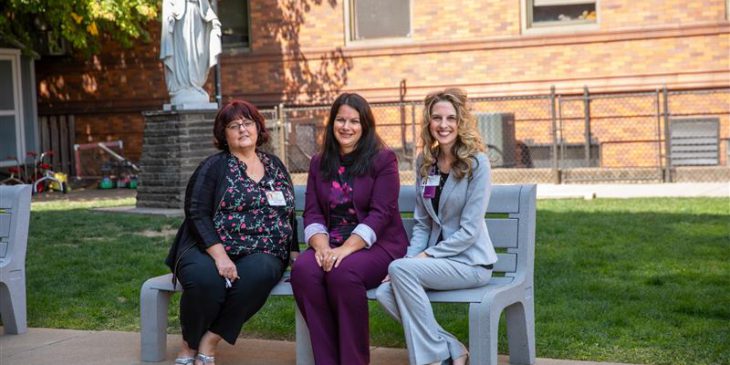UPMC’s Schools of Nursing are more than just educational institutions; they are vital cogs in the machinery that ensures a steady stream of highly qualified and dedicated nurses who are engrained in the UPMC culture and committed to our values. Our schools are integral to cultivating our strong culture, adding to our exemplary nursing workforce, and fostering environments of learning and confidence across our system.
Through their collaborative efforts and unwavering commitment to student success, our schools have continued to innovate strategies for future growth. Especially during a time of ever-changing health care demands, UPMC’s commitment to nurturing its own nursing workforce is a cornerstone in addressing the continual staffing challenges seen across the industry.
One Team Across Many Locations
UPMC’s network of nursing schools, which includes programs at UPMC Shadyside, UPMC Mercy, UPMC Jameson, UPMC St. Margaret, UPMC Shadyside at Harrisburg, and UPMC Jameson at Hamot, all offer the opportunity for students to grow their careers while simultaneously becoming deeply embedded in the UPMC culture.
While each school presents a unique educational experience to students, the leadership teams across the schools collaborate closely to ensure student well-being and success is at the forefront.
“We are not each other’s competition,” said Angela Balistrieri, director, UPMC Mercy School of Nursing. “We are sister schools.”
The directors meet frequently to discuss opportunities and challenges and celebrate wins. “All of us directors bring something different to the table,” said Penny Lenig-Zerby, director, UPMC Shadyside School of Nursing at UPMC Harrisburg.
“We all have different expertise and experiences that lend themselves to strong collaboration. We provide a strong support system for each other as we navigate our various areas.”
Despite all locations being accredited separately, the schools share best practices and standardize curriculum and policies. Further highlighting the schools’ and leadership teams’ collaborative nature, Brandy Hershberger, DNP, chief nursing officer and vice president, Academic Affairs, UPMC Center for Nursing Excellence, echoed that the schools work together to best serve the students and communities in which they’re located.
“Strategic decisions about growth, process innovations, or program details are made based on market needs,” said Brandy. “Each school and location offers a little something different to cater to that community.”
For example, UPMC Mercy offers a summer term start, in addition to its fall term, while UPMC Shadyside offers fall-start, January-start, and part-time programs.
LPN bridge programs are offered at UPMC St. Margaret, UPMC Jameson, and UPMC Hamot. UPMC Shadyside at Harrisburg offers students the opportunity to complete college level courses as part of the curriculum plan in partnership with Harrisburg University of Science and Technology. Each school provides something different to best serve its students.
“We are always evolving to capture the needs,” said Corie Schultheis, assistant director, UPMC Shadyside School of Nursing. “All of these decisions and tweaks from one location to another ultimately are implemented to impact our students in one way or another. Everything we do filters down to them.”
Each school provides something different to best serve its students.
A Legacy of Excellence Fosters Growth
Historically, UPMC’s commitment to in-house education has deep roots. The Shadyside, Mercy, and Jameson programs have all been established for more than 100 years.
“In the past, hospitals didn’t hire nurses, they built them,” said Angela. “While many hospital-based nursing programs have gone away, UPMC still sees the value in educating our own, reflecting a long-standing belief in the value of nurturing internal talent.”
The branch campus locations of UPMC Jameson and UPMC Shadyside, located in Erie at UPMC Hamot and in Harrisburg at UPMC Harrisburg, respectively, were added in recent years in response to growing community interest.
“We had a need in Central Pa., which is why we created the UPMC Shadyside School of Nursing at Harrisburg,” said Penny. “While we know students have plenty of options, we also know they trust the UPMC name and value what we can offer them based on our strong history.”
This growth can also be seen in the Pittsburgh-based programs, many of which have doubled in size, added additional start terms, or have expanded to include a hybrid or extended program offering. UPMC Shadyside’s school will soon begin construction to add more space, while UPMC Mercy’s school has similarly expanded its space.
On the academic side, student success managers have also been added in recent years to help students through their academic journey.
“Most of our programs are waitlisted,” said Brandy. “While the pandemic discouraged some from working in health care, it also energized many others to pursue a career in nursing and be a part of the overall good.”
The team attributes this growth and increased interest to UPMC’s strong curriculum, reputation, and high-quality faculty and facilities.
Strengthening Our Nursing Pipeline
“UPMC continues to invest in our Schools of Nursing. This all did not happen in a day; the investments have been made over time to support our faculty, students, facilities, and ultimately our nursing pipeline,” said Brandy.
The investment and growth our UPMC Schools of Nursing have seen in recent years is a direct result of UPMC responding to the nursing staffing needs we feel across the health care industry.
“Institutions like Shadyside, Shadyside at Harrisburg, and Mercy have shown significant growth, reflecting the organization’s effort to address nursing shortages,” said Brandy. “Our schools are crucial for helping us to fill vacancies at a high quality.”
Students who complete a nursing program at one of our UPMC Schools of Nursing are already fully immersed in our environment from the start. They’re engrained in the culture and adopt our values and behaviors before ever being employed as a full-time UPMC nurse. Even small details like understanding how huddles are run, what hourly rounding is, and learning our communication frameworks like AIDET all contribute to the increased preparedness and comfort with UPMC for these nurses.
This additional time spent understanding UPMC and getting to know the culture often leads to an increased feeling of dedication to the system, according to the directors. The first graduating class at Harrisburg saw a 93% retention rate, meaning that’s the rate of students who signed on for full-time employment with UPMC.
“Students feel a connection to the hospital even before becoming RNs, which supports their decision to stay with us,” said Penny. “The familial atmosphere cultivated at our schools significantly contributes to nurse retainment.”
While not all students will remain at the hospital in which they received their education, most will remain with UPMC, which still positively impacts our patients and teams across the system. This desire to stay on board post-graduation ultimately helps to fill immediate needs while supporting long-term growth across UPMC as well.
Angela is a perfect example of this, as she was a graduate of the UPMC Mercy School of Nursing and is now at its helm.
“Most of our faculty are UPMC grown, too,” said Angela. “Our schools provide opportunities across the board for growth and employment.”
Looking to the Future
“Our goals are always to produce competent, safe nurses that are engaged in their profession for a long time,” said Angela. “How we accomplish this morphs over time, but this is always our focus.”
Amidst changing student needs, student demographics, and curriculum as time passes, UPMC’s Schools of Nursing remain strong in their endeavor to be the best for their students and ultimately their community members. The education provided at our locations impacts the patients we serve every day.
“We’re committed to maintaining high enrollment and focusing on successful outcomes for our students,” said Brandy. “We’re not just teaching nursing skills, we’re addressing the whole picture of students’ lives, ensuring they have the support they need to succeed.”
In recent years, the student diversity across our programs has evolved too. We now have a larger age range of students, from 17-year-olds to those in their 60s, which requires us to continually adapt how we educate to ensure we’re meeting all the various needs.
Students are also more frequently supporting families or seeking a career change through their enrollment. Our schools are educating fewer “traditional students” than in the past and are evolving to meet the needs of this newer demographic.
“We’ve strengthened our resources and support that we provide and will continue to do so,” said Corie. “This summer, we had 10 students inducted into the honor society and all of them were pursuing nursing as a second career. This is a testament to the direction we are heading in.”
Regardless of student diversity, program location, or program type, UPMC Schools of Nursing are meeting the needs of those they serve, while simultaneously supporting the system’s nursing pipeline.









